Target Information
| Target General Information | Top | |||||
|---|---|---|---|---|---|---|
| Target ID |
T95616
(Former ID: TTDR00699)
|
|||||
| Target Name |
Integrin alpha-M (ITGAM)
|
|||||
| Synonyms |
Neutrophil adherence receptor; Leukocyte adhesion receptor MO1; Cell surface glycoprotein Mac-1; Cell surface glycoprotein MAC-1 subunit alpha; Cell surface glycoprotein MAC-1 alpha subunit; CR3A; CR-3 alpha chain; CD11b; CD11 antigen-like family member B
Click to Show/Hide
|
|||||
| Gene Name |
ITGAM
|
|||||
| Target Type |
Clinical trial target
|
[1] | ||||
| Disease | [+] 1 Target-related Diseases | + | ||||
| 1 | Pancreatic cancer [ICD-11: 2C10] | |||||
| Function |
It is identical with CR-3, the receptor for the iC3b fragment of the third complement component. It probably recognizes the R-G-D peptide in C3b. Integrin ITGAM/ITGB2 is also a receptor for fibrinogen, factor X and ICAM1. It recognizes P1 and P2 peptides of fibrinogen gamma chain. Regulates neutrophil migration. In association with beta subunit ITGB2/CD18, required for CD177-PRTN3-mediated activation of TNF primed neutrophils. May regulate phagocytosis-induced apoptosis in extravasated neutrophils. May play a role in mast cell development. Required with TYROBP/DAP12 in microglia to control production of microglial superoxide ions which promote the neuronal apoptosis that occurs during brain development. Integrin ITGAM/ITGB2 is implicated in various adhesive interactions of monocytes, macrophages and granulocytes as well as in mediating the uptake of complement-coated particles and pathogens.
Click to Show/Hide
|
|||||
| BioChemical Class |
Integrin
|
|||||
| UniProt ID | ||||||
| Sequence |
MALRVLLLTALTLCHGFNLDTENAMTFQENARGFGQSVVQLQGSRVVVGAPQEIVAANQR
GSLYQCDYSTGSCEPIRLQVPVEAVNMSLGLSLAATTSPPQLLACGPTVHQTCSENTYVK GLCFLFGSNLRQQPQKFPEALRGCPQEDSDIAFLIDGSGSIIPHDFRRMKEFVSTVMEQL KKSKTLFSLMQYSEEFRIHFTFKEFQNNPNPRSLVKPITQLLGRTHTATGIRKVVRELFN ITNGARKNAFKILVVITDGEKFGDPLGYEDVIPEADREGVIRYVIGVGDAFRSEKSRQEL NTIASKPPRDHVFQVNNFEALKTIQNQLREKIFAIEGTQTGSSSSFEHEMSQEGFSAAIT SNGPLLSTVGSYDWAGGVFLYTSKEKSTFINMTRVDSDMNDAYLGYAAAIILRNRVQSLV LGAPRYQHIGLVAMFRQNTGMWESNANVKGTQIGAYFGASLCSVDVDSNGSTDLVLIGAP HYYEQTRGGQVSVCPLPRGRARWQCDAVLYGEQGQPWGRFGAALTVLGDVNGDKLTDVAI GAPGEEDNRGAVYLFHGTSGSGISPSHSQRIAGSKLSPRLQYFGQSLSGGQDLTMDGLVD LTVGAQGHVLLLRSQPVLRVKAIMEFNPREVARNVFECNDQVVKGKEAGEVRVCLHVQKS TRDRLREGQIQSVVTYDLALDSGRPHSRAVFNETKNSTRRQTQVLGLTQTCETLKLQLPN CIEDPVSPIVLRLNFSLVGTPLSAFGNLRPVLAEDAQRLFTALFPFEKNCGNDNICQDDL SITFSFMSLDCLVVGGPREFNVTVTVRNDGEDSYRTQVTFFFPLDLSYRKVSTLQNQRSQ RSWRLACESASSTEVSGALKSTSCSINHPIFPENSEVTFNITFDVDSKASLGNKLLLKAN VTSENNMPRTNKTEFQLELPVKYAVYMVVTSHGVSTKYLNFTASENTSRVMQHQYQVSNL GQRSLPISLVFLVPVRLNQTVIWDRPQVTFSENLSSTCHTKERLPSHSDFLAELRKAPVV NCSIAVCQRIQCDIPFFGIQEEFNATLKGNLSFDWYIKTSHNHLLIVSTAEILFNDSVFT LLPGQGAFVRSQTETKVEPFEVPNPLPLIVGSSVGGLLLLALITAALYKLGFFKRQYKDM MSEGGPPGAEPQ Click to Show/Hide
|
|||||
| 3D Structure | Click to Show 3D Structure of This Target | AlphaFold | ||||
| ADReCS ID | BADD_A01381 | |||||
| HIT2.0 ID | T32IXS | |||||
| Drugs and Modes of Action | Top | |||||
|---|---|---|---|---|---|---|
| Clinical Trial Drug(s) | [+] 1 Clinical Trial Drugs | + | ||||
| 1 | GB1275 | Drug Info | Phase 1/2 | Pancreatic cancer | [2] | |
| Mode of Action | [+] 1 Modes of Action | + | ||||
| Agonist | [+] 1 Agonist drugs | + | ||||
| 1 | GB1275 | Drug Info | [3] | |||
| Cell-based Target Expression Variations | Top | |||||
|---|---|---|---|---|---|---|
| Cell-based Target Expression Variations | ||||||
| Drug Binding Sites of Target | Top | |||||
|---|---|---|---|---|---|---|
| Ligand Name: Simvastatin acid | Ligand Info | |||||
| Structure Description | Structural basis for simvastatin competitive antagonism of complement receptor 3 | PDB:4XW2 | ||||
| Method | X-ray diffraction | Resolution | 2.00 Å | Mutation | No | [4] |
| PDB Sequence |
DSDIAFLIDG
141 SGSIIPHDFR151 RMKEFVSTVM161 EQLKKSKTLF171 SLMQYSEEFR181 IHFTFKEFQN 191 NPNPRSLVKP201 ITQLLGRTHT211 ATGIRKVVRE221 LFNITNGARK231 NAFKILVVIT 241 DGEKFGDPLG251 YEDVIPEADR261 EGVIRYVIGV271 GDAFRSEKSR281 QELNTIASKP 291 PRDHVFQVNN301 FEALKTIQNQ311 LREK
|
|||||
|
|
||||||
| Click to View More Binding Site Information of This Target with Different Ligands | ||||||
| Different Human System Profiles of Target | Top |
|---|---|
|
Human Similarity Proteins
of target is determined by comparing the sequence similarity of all human proteins with the target based on BLAST. The similarity proteins for a target are defined as the proteins with E-value < 0.005 and outside the protein families of the target.
A target that has fewer human similarity proteins outside its family is commonly regarded to possess a greater capacity to avoid undesired interactions and thus increase the possibility of finding successful drugs
(Brief Bioinform, 21: 649-662, 2020).
Human Tissue Distribution
of target is determined from a proteomics study that quantified more than 12,000 genes across 32 normal human tissues. Tissue Specificity (TS) score was used to define the enrichment of target across tissues.
The distribution of targets among different tissues or organs need to be taken into consideration when assessing the target druggability, as it is generally accepted that the wider the target distribution, the greater the concern over potential adverse effects
(Nat Rev Drug Discov, 20: 64-81, 2021).
Human Pathway Affiliation
of target is determined by the life-essential pathways provided on KEGG database. The target-affiliated pathways were defined based on the following two criteria (a) the pathways of the studied target should be life-essential for both healthy individuals and patients, and (b) the studied target should occupy an upstream position in the pathways and therefore had the ability to regulate biological function.
Targets involved in a fewer pathways have greater likelihood to be successfully developed, while those associated with more human pathways increase the chance of undesirable interferences with other human processes
(Pharmacol Rev, 58: 259-279, 2006).
Biological Network Descriptors
of target is determined based on a human protein-protein interactions (PPI) network consisting of 9,309 proteins and 52,713 PPIs, which were with a high confidence score of ≥ 0.95 collected from STRING database.
The network properties of targets based on protein-protein interactions (PPIs) have been widely adopted for the assessment of target’s druggability. Proteins with high node degree tend to have a high impact on network function through multiple interactions, while proteins with high betweenness centrality are regarded to be central for communication in interaction networks and regulate the flow of signaling information
(Front Pharmacol, 9, 1245, 2018;
Curr Opin Struct Biol. 44:134-142, 2017).
Human Similarity Proteins
Human Tissue Distribution
Human Pathway Affiliation
Biological Network Descriptors
|
|
|
There is no similarity protein (E value < 0.005) for this target
|
|
Note:
If a protein has TS (tissue specficity) scores at least in one tissue >= 2.5, this protein is called tissue-enriched (including tissue-enriched-but-not-specific and tissue-specific). In the plots, the vertical lines are at thresholds 2.5 and 4.
|
| KEGG Pathway | Pathway ID | Affiliated Target | Pathway Map |
|---|---|---|---|
| Rap1 signaling pathway | hsa04015 | Affiliated Target |
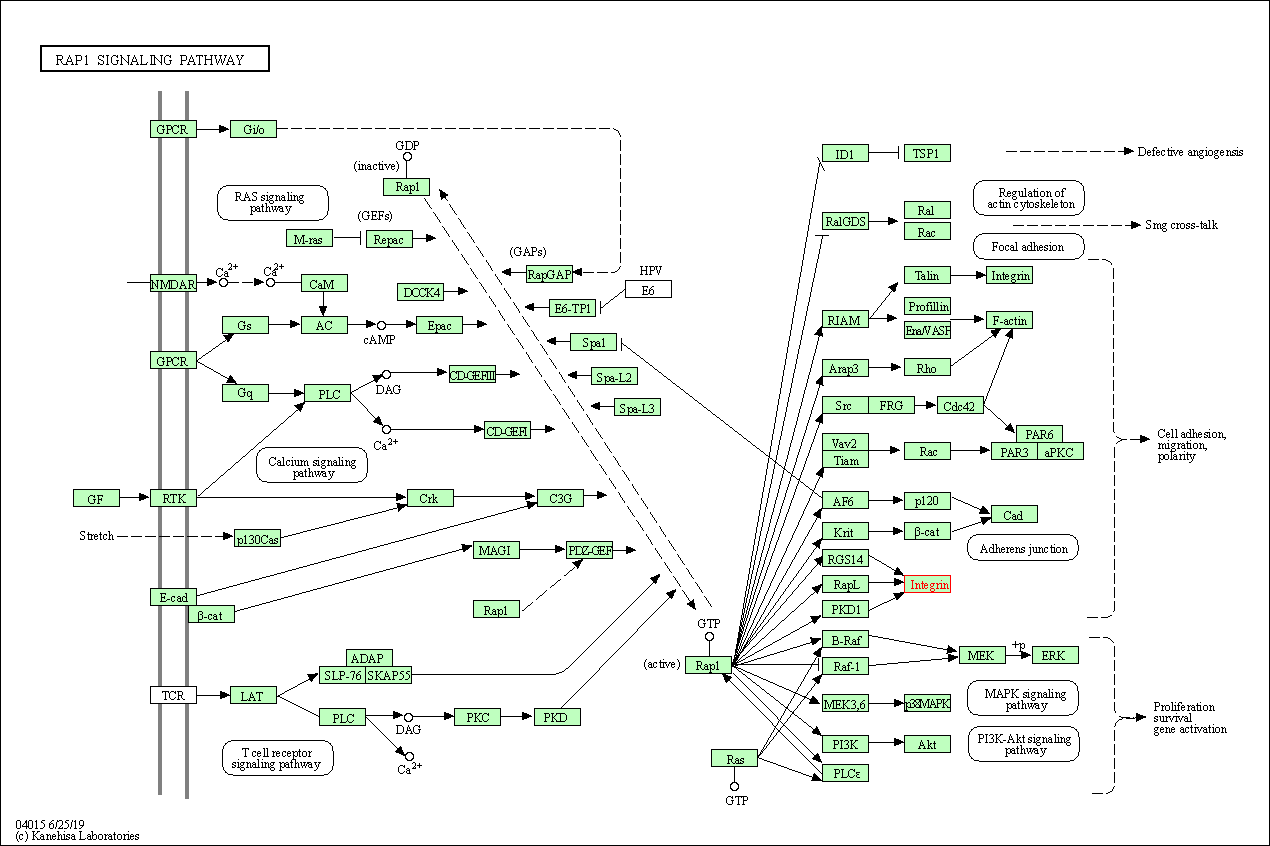
|
| Class: Environmental Information Processing => Signal transduction | Pathway Hierarchy | ||
| Phagosome | hsa04145 | Affiliated Target |

|
| Class: Cellular Processes => Transport and catabolism | Pathway Hierarchy | ||
| Cell adhesion molecules | hsa04514 | Affiliated Target |
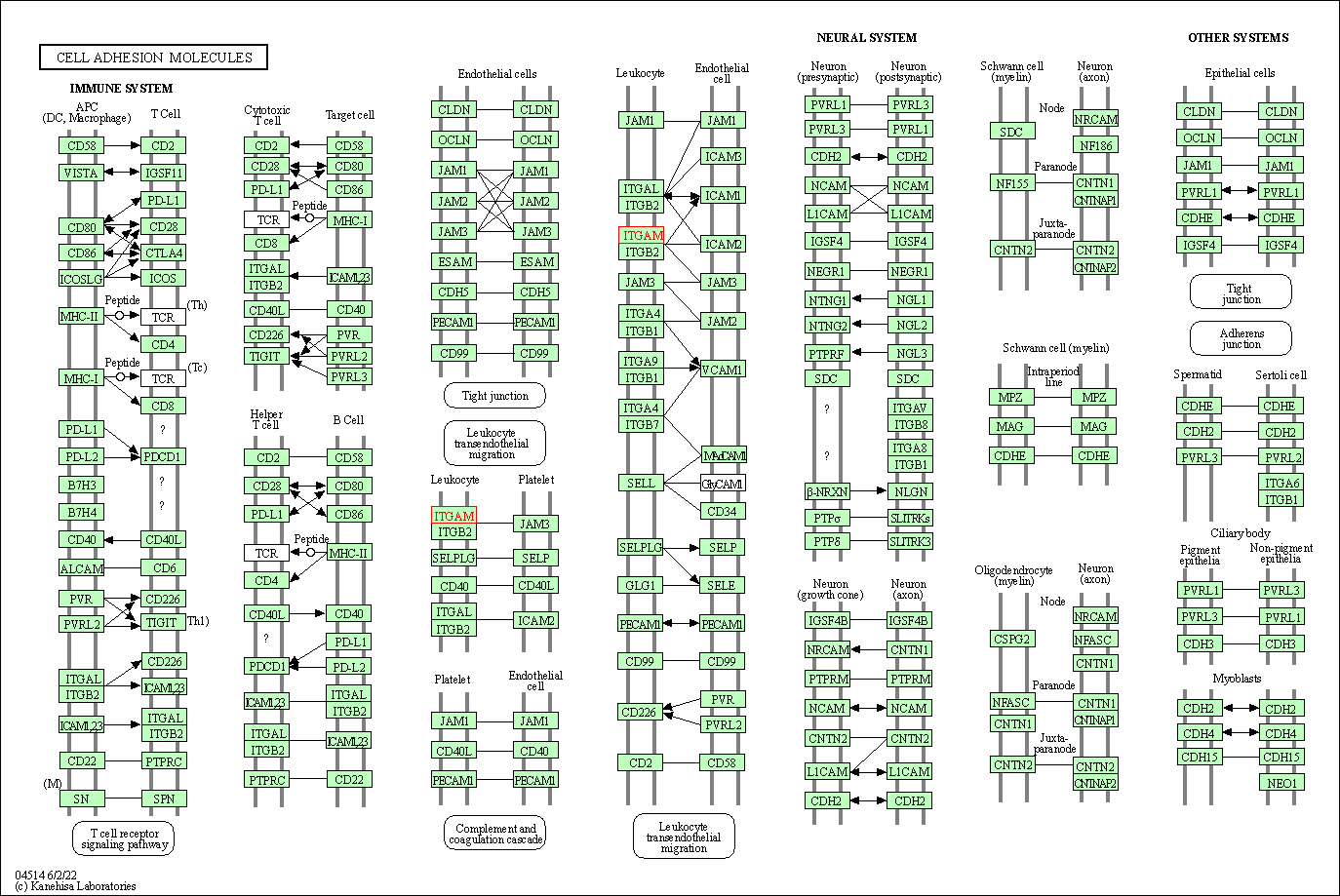
|
| Class: Environmental Information Processing => Signaling molecules and interaction | Pathway Hierarchy | ||
| Complement and coagulation cascades | hsa04610 | Affiliated Target |
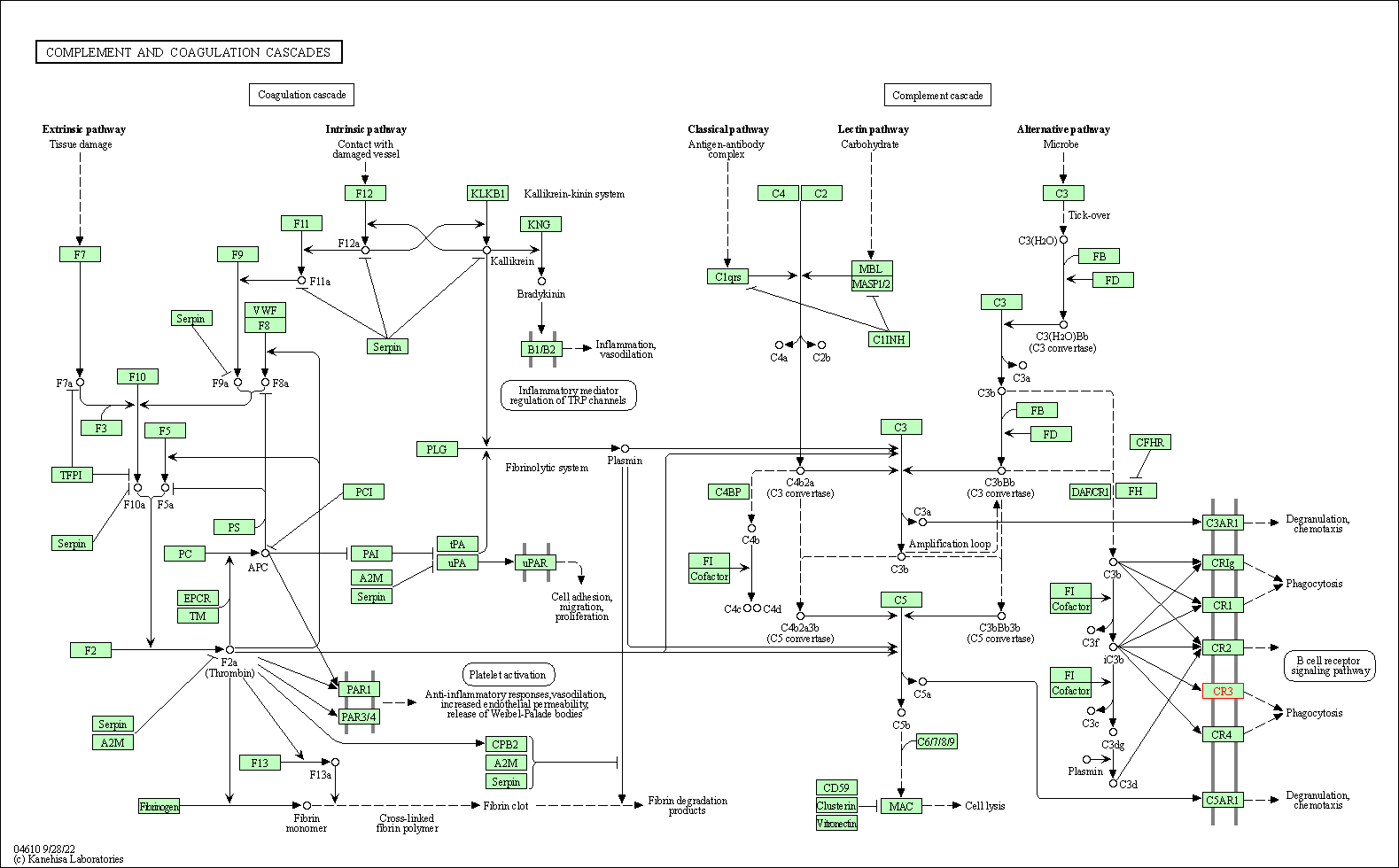
|
| Class: Organismal Systems => Immune system | Pathway Hierarchy | ||
| Neutrophil extracellular trap formation | hsa04613 | Affiliated Target |
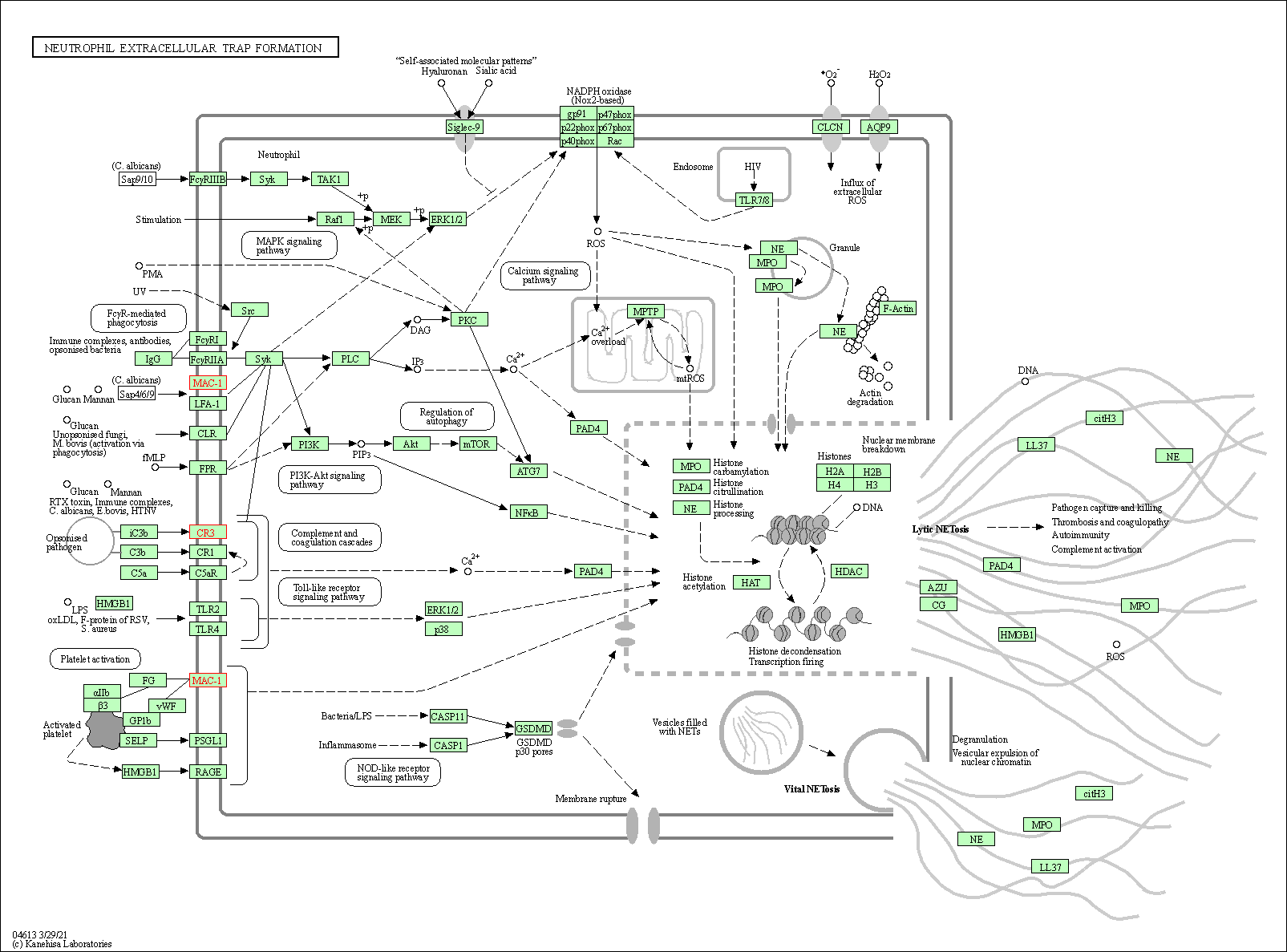
|
| Class: Organismal Systems => Immune system | Pathway Hierarchy | ||
| Hematopoietic cell lineage | hsa04640 | Affiliated Target |
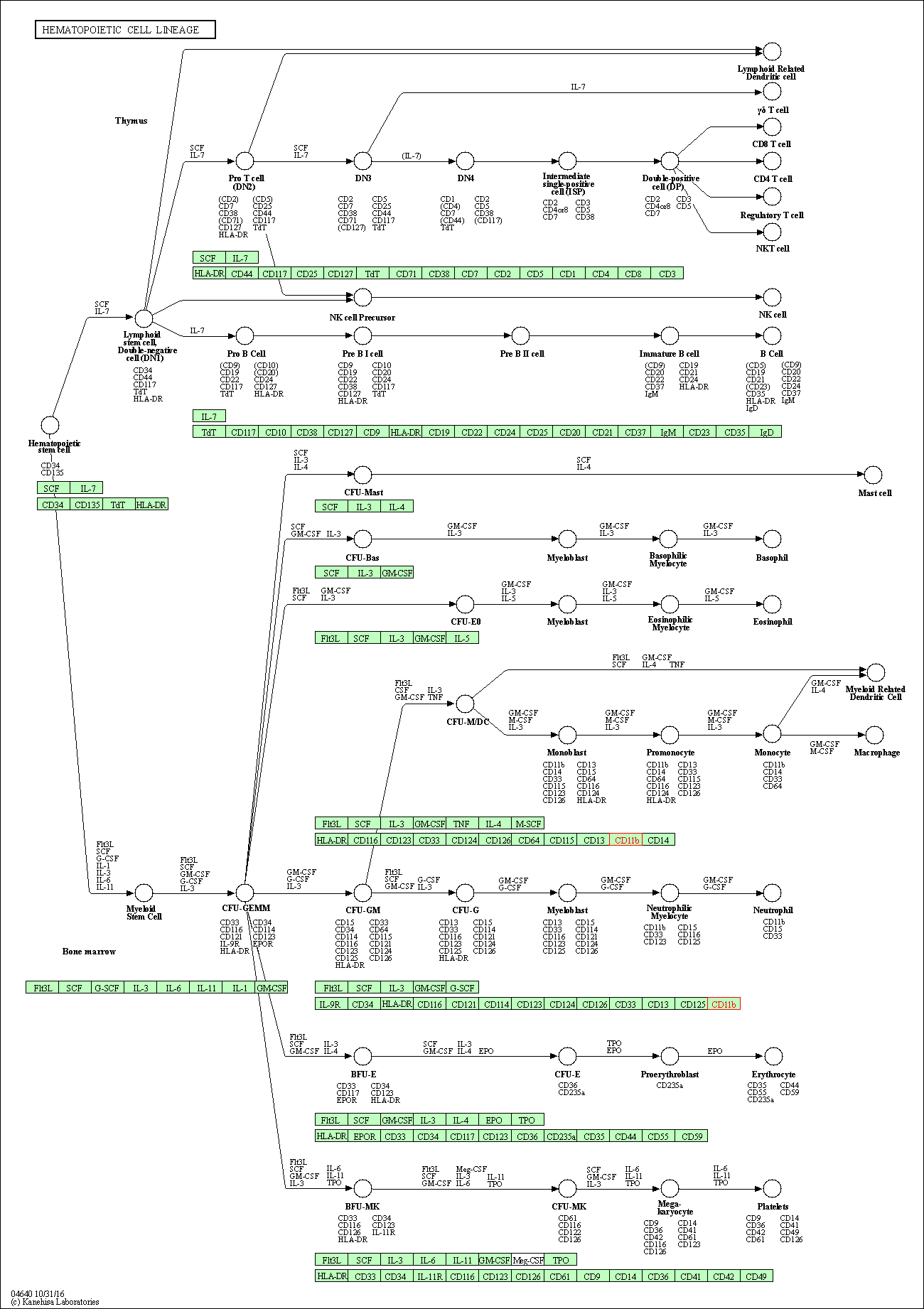
|
| Class: Organismal Systems => Immune system | Pathway Hierarchy | ||
| Leukocyte transendothelial migration | hsa04670 | Affiliated Target |
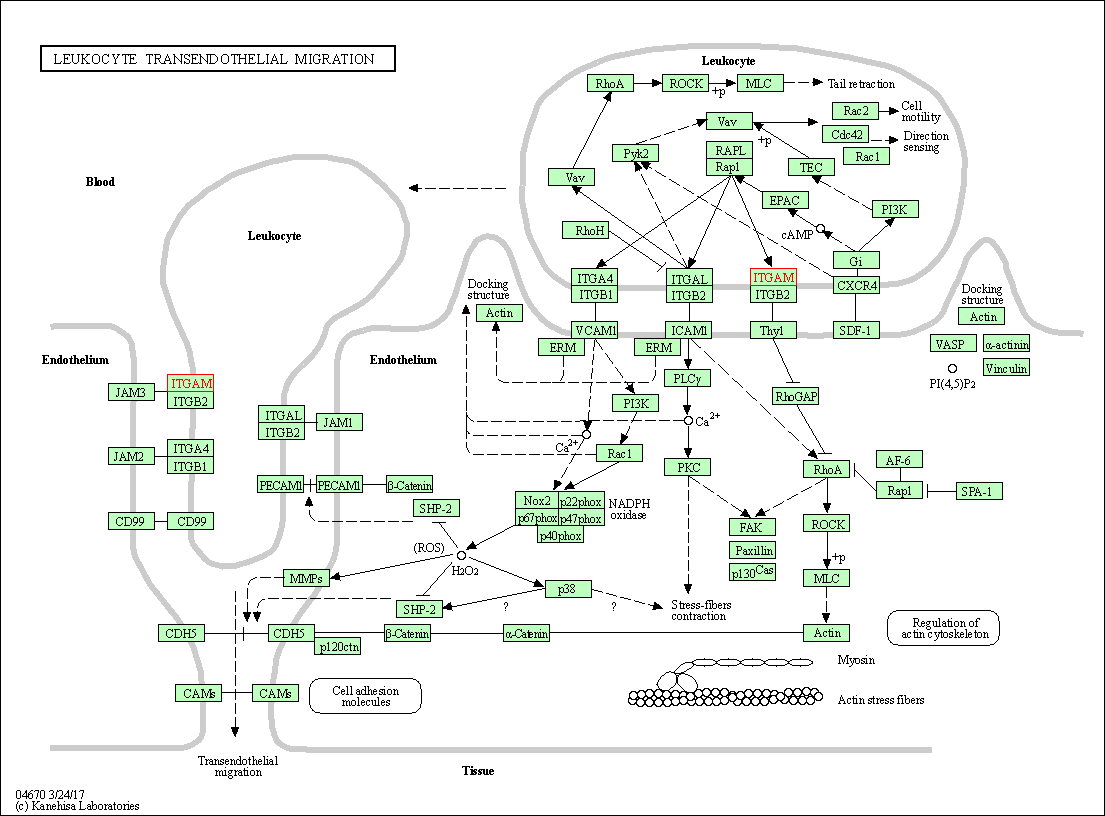
|
| Class: Organismal Systems => Immune system | Pathway Hierarchy | ||
| Regulation of actin cytoskeleton | hsa04810 | Affiliated Target |
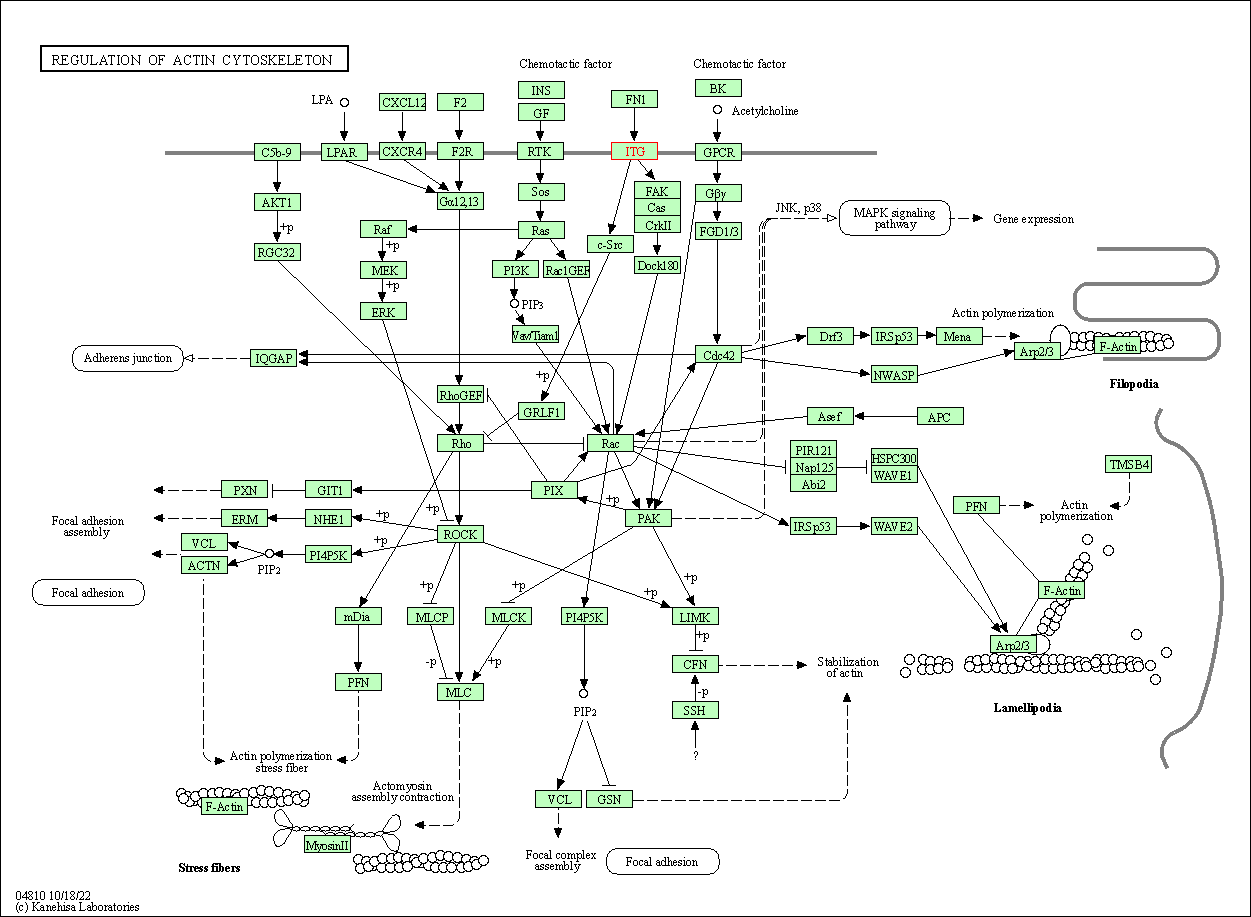
|
| Class: Cellular Processes => Cell motility | Pathway Hierarchy | ||
| Click to Show/Hide the Information of Affiliated Human Pathways | |||
| Degree | 26 | Degree centrality | 2.79E-03 | Betweenness centrality | 2.33E-03 |
|---|---|---|---|---|---|
| Closeness centrality | 2.25E-01 | Radiality | 1.40E+01 | Clustering coefficient | 1.02E-01 |
| Neighborhood connectivity | 1.76E+01 | Topological coefficient | 6.12E-02 | Eccentricity | 12 |
| Download | Click to Download the Full PPI Network of This Target | ||||
| References | Top | |||||
|---|---|---|---|---|---|---|
| REF 1 | Biomarkers of eosinophil involvement in allergic and eosinophilic diseases: review of phenotypic and serum markers including a novel assay to quantify levels of soluble Siglec-8. J Immunol Methods. 2012 Sep 28;383(1-2):39-46. | |||||
| REF 2 | ClinicalTrials.gov (NCT04060342) GB1275 Monotherapy and in Combination With an Anti-PD1 Antibody in Patients With Specified Advanced Solid Tumors or in Combination With Standard of Care in Patients With Metastatic Pancreatic Adenocarcinoma. U.S. National Institutes of Health. | |||||
| REF 3 | National Cancer Institute Drug Dictionary (drug name GB1275). | |||||
| REF 4 | Structural Basis for Simvastatin Competitive Antagonism of Complement Receptor 3. J Biol Chem. 2016 Aug 12;291(33):16963-76. | |||||
If You Find Any Error in Data or Bug in Web Service, Please Kindly Report It to Dr. Zhou and Dr. Zhang.

